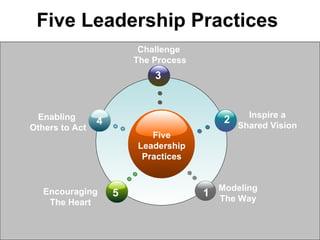Leadership challenge follow up clinic
- 1. The Challenge continues your journey to becoming a stronger leader. Follow-up Clinic-1
- 2. Objectives Refresh 1 Identify & overcome challenges 2 Motivate & coach 3 Partner your leadership journey 4 Refresh
- 3. Five Leadership Practices Challenge The Process Inspire a Shared Vision Modeling The Way Enabling Others to Act Encouraging The Heart Five Leadership Practices 1 2 3 4 5
- 4. Practice 1- Model The Way
- 5. Two Commitments - MTW Find your voice by clarify your personal values Set example by aligning your personal action with shared values
- 6. Practice 2- Inspire a Shared Vision
- 7. Two Commitments - ISV Envision the future by imagining exciting and ennobling possibilities. Enlist others in a common vision by appealing to shared aspirations.
- 8. Practice 3 - Challenge The Process
- 9. Two Commitments - CTP Search for opportunities by seizing the initiative and by looking outward for innovative ways to improve. Experiment and take risks by constantly generating small wins and learning from experience.
- 10. Practice 4 ŌĆō Enable Others To Act
- 11. Two Commitments - EOTA Foster collaboration by building trust and facilitating relationships. Strengthen others by increasing self-determination and developing competence.
- 12. Practice 5- Encouraging The Heart
- 13. Two Commitments- ECTH Recognize contributions by showing appreciation for individual excellence. Celebrate the values and victories by creating a spirit of community.
- 14. Peer Learning Form groups of similar practice Share your small wins with the group Capture your success stories & report out 10 mins
- 15. Common Challenges Lack of time. Lack of self discipline/commitment. Face resistance from employees. No opportunity to practice. Employees suspect my intention. EmployeesŌĆÖ strong mindset. Overwhelmed by work priorities. Others
- 16. Why is it important to practice your leadership skills? Danger of stagnation Long lead time to be a leader Early head start strategy Your profession T- Professionals in demand Minimise personal stress Increase self-awareness
- 17. High & Low Payoff Activities Low Pay-off Activities Productive Effort High Pay-off Activities Spending time doing the right thing, in the right way, at the right time and for the right length of time Spending time on activities that are worth less than the time you must invest to accomplish it.
- 18. It is part of your job. DonŌĆÖt treat it as a secondary function, which you perform when you have the time. Your commitment to this profession should be of the highest priority
- 19. T-shaped Professionals Ability to apply knowledge across different situations Examples: Marketing Management Finance Business operations etc Examples: Industrial designer Architect Engineers Business specialist etc SPECIALIZED GENERALIST BROAD D E E P Functional Disciplinary Skills
- 21. Improve Commitment to Your Leadership Growth Incorporate your Leadership Practice application into your daily to do list Use Personal Positive Affirmation Technique Apply Visualisation Technique Counter your LV Make progressive small wins Operate a buddy system Celebrate successes
- 22. ╠²






















